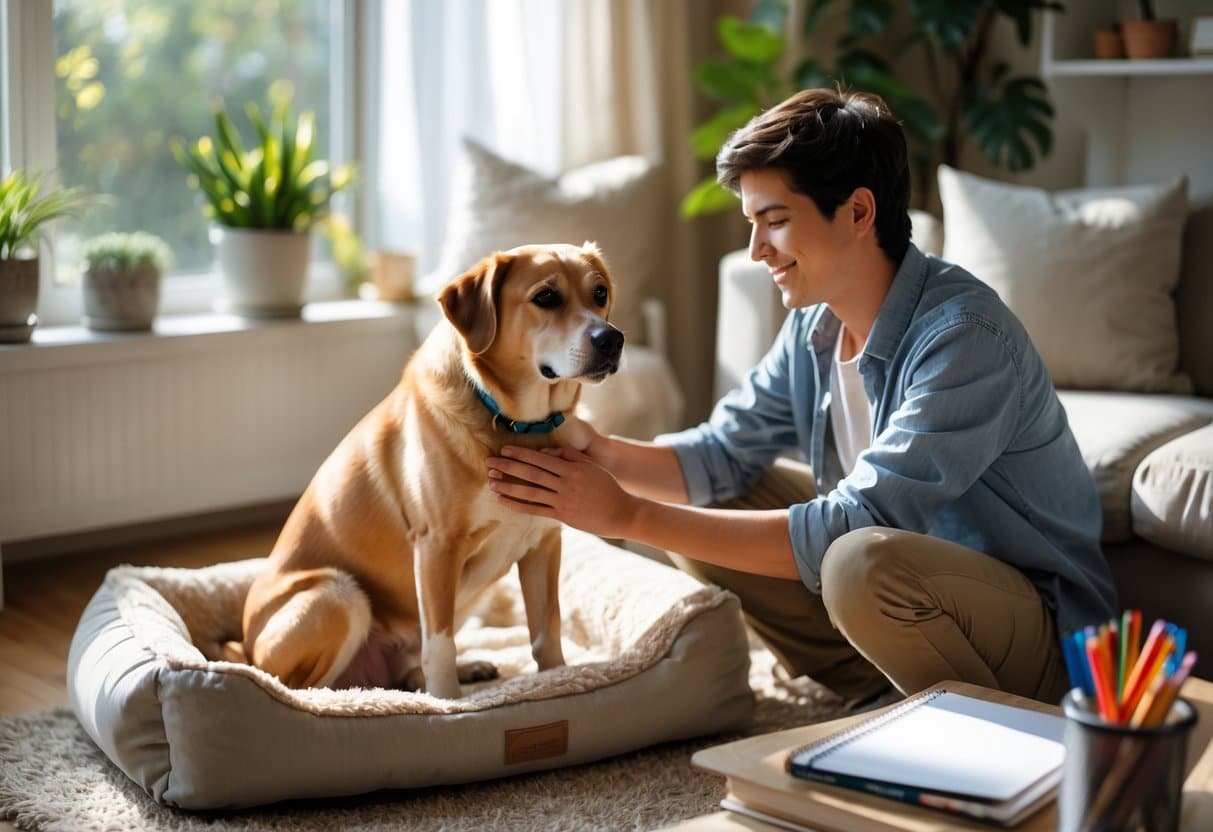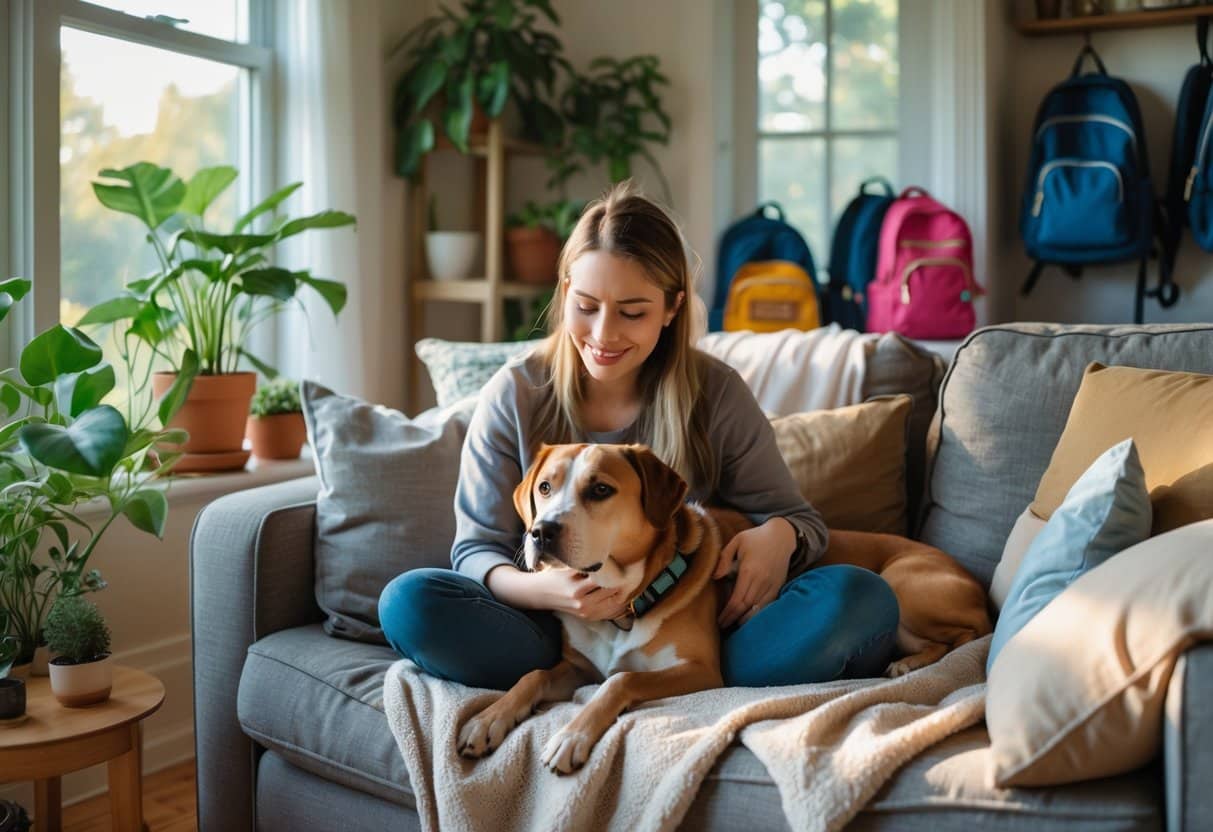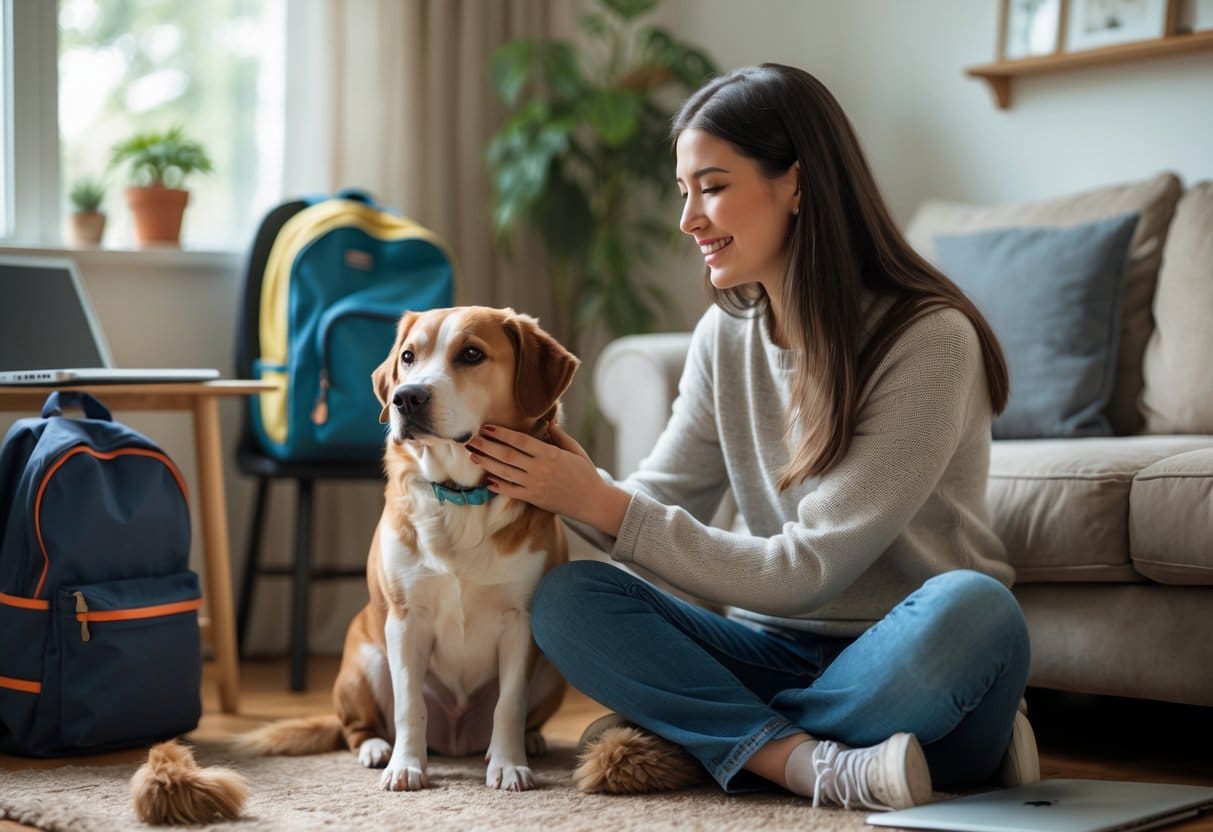
When school kicks back in and families settle into their routines, a lot of dogs start to struggle with stress from being left home alone for longer stretches. This sudden shift can spark destructive habits, nonstop barking, and other behaviors that leave pet owners feeling uneasy.
The trick to helping dogs with separation anxiety during back-to-school is gradual desensitization training—basically, you start where your dog feels safe and slowly stretch their comfort with being alone. It takes time and patience (and honestly, a lot of repetition), but most dogs eventually learn to chill out when the house empties.
Learning the specific signs of separation anxiety and using proven training approaches can make things much easier for everyone. With a thoughtful plan, dogs can figure out that being alone isn’t the end of the world—and yes, their family really will come back.
Key Takeaways
- Start separation training inside your dog’s comfort zone, then slowly stretch alone time to build confidence
- Make the environment calm, offer mental stimulation, and create positive vibes before heading out
- If anxiety symptoms keep ramping up even with steady training, it’s probably time to call in a certified trainer
Understanding Separation Anxiety in Dogs
Separation anxiety in dogs actually affects about 14-20% of pets, and it’s all about extreme stress when they’re left solo. School transitions are especially rough because the whole daily routine gets flipped upside down for both kids and their furry sidekicks.
What Is Separation Anxiety?
Separation anxiety is a real behavioral issue where dogs get seriously upset when they’re apart from their humans. It’s not just a bit of whining—it’s full-on distress.
Dogs with this condition act like being alone is their worst nightmare. Animal behaviorists even compare it to panic attacks in people.
This isn’t the same as boredom or a little mischief. Dogs with true separation anxiety deal with real psychological stress, and it can impact their health in more ways than you’d think.
Key differences from normal behavior:
- Most dogs might whimper for a minute when you leave
- Anxious dogs show several intense symptoms, and it lasts a while
- It’s about genuine fear, not just trying to get attention
Puppies and young dogs seem especially likely to develop this, but older dogs can get it too—especially after big changes in their lives.
Common Signs and Symptoms
Signs of separation anxiety are all over the map, but if you see several symptoms popping up regularly, that’s a red flag. One weird incident probably isn’t a big deal.
Behavioral symptoms include:
- Nonstop barking or howling that goes on and on
- Chewing up stuff, especially near doors and windows
- Potty accidents, even if they’re usually housebroken
- Pacing, whining, or shaking before you leave
Physical symptoms include:
- Drooling way more than usual
- Panting heavily, even when it’s not hot
- Trying desperately to escape confinement
- Hurting themselves trying to get out
The worst cases? Dogs injure themselves clawing at doors or break teeth on crates. It’s heartbreaking to watch.
Setting up a video camera can help you figure out if it’s separation anxiety or something else. A lot of these symptoms only show up when the dog’s totally alone.
Why School Transitions Trigger Anxiety
School transitions are kind of the perfect storm for separation anxiety. Dogs love routines, so when everything changes overnight, it’s tough on them.
Over the summer, kids are around all day, and dogs get used to that constant company. Suddenly, the house goes quiet and empty.
School-related triggers include:
- Kids disappearing after being home nonstop
- New morning rushes and different departure times
- Way less activity and noise during the day
- Changed pickup and drop-off routines
Even dogs who’ve never had issues before can start struggling during these transitions. Big schedule changes are notorious triggers for anxiety.
When the whole family leaves at once, dogs can feel like their entire pack just vanished. No wonder they get stressed out.
Preparing Your Dog for the Back-to-School Routine
Preventing separation anxiety really comes down to making changes slowly, sticking to predictable schedules, and dialing down your dog’s emotional reaction to those “I’m leaving” signals. These strategies, when used together, help dogs feel way more secure during the school day.
Gradual Adjustment to Alone Time
Dogs need a little time to get the hang of being alone for longer stretches. Try starting this two or three weeks before school starts—that way it doesn’t hit all at once.
Begin with quick trips out, like 15 to 30 minutes. Slip out and come back in without a lot of fuss.
Week 1 Practice Schedule:
- Days 1-2: 15 minutes alone
- Days 3-4: 30 minutes alone
- Days 5-7: 45 minutes alone
Week 2 Practice Schedule:
- Days 1-3: 1 hour alone
- Days 4-5: 2 hours alone
- Days 6-7: 3-4 hours alone
Just bump up the time a little each day. If your pup starts freaking out—whining, pacing, whatever—drop back to shorter sessions for a while.
Mix up the times of day you leave, too. That way, departures start to feel pretty normal and not like a big event.
Establishing a Consistent Schedule
Dogs really do better with routines, and sudden changes can throw them for a loop. Try setting up a new daily schedule before school actually begins.
Choose regular times for meals, walks, and bathroom breaks. Feeding at the same times every morning and night helps a lot.
Sample School Day Schedule:
- 6:30 AM: Morning walk and potty break
- 7:00 AM: Breakfast
- 7:45 AM: Quick outdoor time
- 8:00 AM: Family heads out
- 3:30 PM: Afternoon walk when everyone’s home
Try to keep this up on weekends, too. Dogs like knowing what to expect.
Give your dog a mental workout before you leave. A tired, busy pup is less likely to stress out.
Desensitizing Departure Cues
Dogs are smart—they pick up on all the little things you do before leaving. Sometimes, just seeing you grab your keys is enough to set them off.
Departure cues include stuff like picking up keys, slipping on shoes, grabbing backpacks, or getting dressed for work. Some dogs start getting anxious as soon as they notice these moves.
Try practicing these actions without actually leaving. Pick up your keys, then put them down. Put on your shoes, then take them off.
Daily Desensitization Exercise:
- Pick up keys, wait half a minute, put them back
- Put on your coat, chill on the couch for a couple minutes, then take it off
- Touch the door handle, then walk away
- Repeat this a few times a day
Do these little drills when you’re staying home. The goal is to make these cues so boring that your dog stops caring.
A lot of dogs get destructive or anxious as school starts up again. Desensitization helps break that mental link between your departure routine and their stress.
Creating a Comfortable Home Environment

The physical environment really matters when it comes to easing separation anxiety. A cozy, well-thought-out space with soothing sounds and familiar routines can make a big difference for a nervous dog.
Setting Up a Safe Space
Dogs with separation anxiety need a designated spot where they feel safe and relaxed. Think: their bed, a favorite blanket, and maybe something that smells like you.
Pick a quiet room or a corner away from busy windows. Setting up a safe space gives your dog a zone to retreat to when things feel overwhelming.
Must-haves for the safe space:
- Comfy bed or crate with soft bedding
- Fresh water bowl
- A couple favorite toys (nothing too chewable if they’re destructive)
- An old shirt or towel that smells like you
The area shouldn’t be too big or too cramped. Too much space can make some dogs feel lost; too little can feel suffocating.
Keep the temperature reasonable and make sure there’s good airflow. Some dogs like open spaces, while others feel better in a crate with the door open—it’s a bit of trial and error to see what your dog prefers.
Using Background Noise for Comfort
Background sounds can help mask scary noises from outside and offer a calming presence for anxious dogs.
The right audio can really lower stress levels during alone time.
Television or radio works well if you keep the volume at a normal conversation level.
But it’s best to avoid channels with loud commercials, sirens, or other dogs barking—those can actually make things worse.
Effective background noise options:
- Classical music or soft instrumental sounds
- Nature sounds like rain or ocean waves
- White noise machines
- Calm TV programs with steady voices
Music designed specifically for dogs often uses frequencies that promote relaxation.
These specially created tracks might work even better than regular music for separation anxiety.
Start playing background sounds 15-20 minutes before you leave.
This helps build a positive association between the calming audio and alone time.
Managing Departures and Arrivals
How you leave and return home can really affect your dog’s anxiety.
Dramatic goodbyes and excited hellos usually make separation anxiety worse by turning departures and arrivals into emotional rollercoasters.
Keep departures calm and brief.
Skip the long hugs, baby talk, or apologetic tones—they just signal that something bad is about to happen.
Low-key departure routine:
- Gather keys and belongings quietly
- Give a simple “be good” or something short and sweet
- Leave without a lot of eye contact or petting
- Don’t react to whining or following behavior
Returns should be understated too.
Ignore your dog for the first 5-10 minutes after coming home, even if they’re excited or had an accident.
Avoiding dramatic departures helps dogs see leaving and returning as just part of the routine, not a crisis.
Practice departure cues like grabbing keys or putting on shoes without actually leaving.
This helps reduce your dog’s anticipation and stress around those triggers.
Physical and Mental Stimulation
A tired dog is less likely to get into destructive behaviors or bark excessively when left alone.
Physical exercise and mental stimulation are crucial in managing separation anxiety by reducing stress and burning off extra energy before you head out.
Importance of Morning Exercise
Morning exercise really sets the tone for a calmer day when dogs have to stay home alone.
A well-exercised dog is more likely to rest instead of pacing or barking all day.
Recommended Morning Activities:
- 20-30 minute brisk walk
- 10-15 minutes of fetch
- Leash training practice
- Brief running session
The timing matters, not just the activity.
Dogs should finish their exercise at least 30 minutes before you leave so they have time to cool down and settle.
Mental exercise during walks is just as important as the physical stuff.
Having your dog heel or practice commands engages their mind while they’re moving.
High-energy breeds need a bit more in the morning.
These dogs do best with a combo of walking, fetch, or even some agility exercises.
Interactive Toys and Mental Enrichment
Mental stimulation is kind of a secret weapon against separation anxiety.
When dogs have something to focus on, they’re less likely to obsess over your absence.
Effective Mental Enrichment Options:
| Toy Type | Duration | Best For |
|---|---|---|
| Puzzle feeders | 15-30 minutes | Problem solvers |
| Snuffle mats | 10-20 minutes | Scent-driven dogs |
| Interactive balls | 20-45 minutes | Active chewers |
| Hide-and-seek games | 5-15 minutes | Curious dogs |
Rotating toys keeps things interesting.
Introduce new toys gradually and take them away after a few days, so your dog doesn’t get bored.
Understimulation can lead to behavioral issues like barking and chewing up stuff they shouldn’t.
Dogs need both physical movement and mental challenges to feel satisfied.
Utilizing Treat-Dispensing Activities
Treat-dispensing toys can create positive associations with alone time and keep dogs busy for longer stretches.
These activities channel anxious energy into something productive (and, honestly, more fun for the dog).
Popular Treat-Dispensing Methods:
- Frozen Kong toys stuffed with peanut butter
- Puzzle feeders that release kibble slowly
- Treat balls that dispense food as they play
- Hidden treats around the house
Frozen treats are great because they last longer and provide a bit of cooling relief.
Try stuffing hollow bones with wet food and freezing them overnight for the next day.
The trick is to give these special treats only when you leave.
That way, your absence becomes something your dog can actually look forward to.
Safety’s important, too—make sure treat-dispensing toys are the right size and made from non-toxic materials.
You don’t want anything that could break into dangerous pieces.
Positive Reinforcement and Behavior Training

Training dogs with separation anxiety is all about rewarding calm behaviors and shifting how they feel about being alone.
The focus is on positive associations—not punishing anxious behaviors.
Counterconditioning Techniques
Counterconditioning basically means you’re teaching your dog that being left alone comes with good things.
This approach helps dogs build confidence and a little more emotional resilience when you’re not around.
High-Value Treats and Activities
Hand out special treats only when you leave the house.
Kong toys with peanut butter or frozen snacks work well for this.
Take these items away when you get home to really cement that connection between being alone and getting rewards.
Gradual Separation Training
Start with super short departures—maybe 30 seconds to a couple of minutes.
Practice leaving for short periods that don’t trigger anxiety and build up from there.
Mix up the length of time you’re gone so your dog doesn’t get anxious waiting for your exact return.
Desensitization to Departure Cues
Do things like pick up your keys, put on your shoes, or grab your bag without actually leaving.
Repeat these throughout the day, even when you’re staying home.
This helps your dog chill out when they see those cues.
Rewarding Calm Behavior
Positive reinforcement is the way to go—treats, praise, and rewards for calm behavior instead of scolding anxious reactions.
Timing and consistency really matter here.
Identifying Calm Moments
Look for relaxed body language—lying down, slow breathing, or just being quiet.
Reward those moments right away with treats or gentle praise.
Even a few seconds of calm deserve recognition.
Dogs catch on quicker when you notice the good stuff.
Training Schedule Guidelines
| Training Element | Recommendation |
|---|---|
| Daily sessions | 30 minutes maximum |
| Rest days | At least 1 day per week |
| Session length | 5-10 minutes each |
Take breaks from training so you and your dog don’t get burned out.
This kind of training really does require patience and a steady approach.
Avoiding Common Mistakes
Don’t punish barking, whining, or chewing—those are fear responses, not bad manners.
Keep greetings and departures low-key, always.
Big hellos and goodbyes just ramp up the emotional swings between together time and alone time.
When to Seek Professional Help
Sometimes, dogs need expert guidance if the usual training tricks aren’t helping.
If symptoms stick around or get worse, it might be time to call in a pro.
Consulting a Veterinarian
If your dog shows severe separation anxiety—like destructive behavior, nonstop barking, or self-injury—get a vet involved.
Vets can check for medical issues that might look like anxiety.
Things like urinary tract infections, tummy troubles, or pain can all make dogs act out.
Medical signs that need vet attention:
- Accidents in the house after being potty trained
- Loss of appetite for more than 24 hours
- Excessive drooling or panting
- Self-harm like licking or scratching too much
For severe cases, veterinarians may prescribe anti-anxiety meds—these work best alongside behavior training.
Fluoxetine or sertraline are common options, but your vet will know what’s safest.
They might also talk about natural supplements.
Stuff like L-theanine or melatonin can help calm anxious pups in a gentler way.
Working with a Dog Trainer or Behaviorist
Certified animal behaviorists can put together custom training plans for dogs struggling with separation anxiety. They tend to use methods that actually help dogs feel safer when alone, not just generic advice.
Professional trainers usually focus on desensitization. That means slowly building up the time your dog’s left alone, but always making sure they stay calm and comfortable throughout.
Key training methods include:
- Counter-conditioning exercises
- Positive reinforcement strategies
- Departure routine changes
- Independence building activities
Professional help becomes essential when destructive behaviors just won’t quit, even after you’ve tried home training. Trainers often spot triggers that owners overlook.
Behaviorists also coach owners on what actually works. It’s surprisingly easy to accidentally reinforce anxious behaviors—like when you make a big deal out of leaving or coming home.
Supporting Your Dog with Additional Strategies
These days, professional care services and tech gadgets can really help manage separation anxiety, especially during school transitions. It’s all about keeping dogs calm and giving them some sense of security, even when you’re not there.
Doggy Daycare and Pet Sitters
Doggy daycare centers offer structured environments where dogs get plenty of attention and social time. Staff are usually trained to spot anxiety and step in when needed. Plus, most places mix in exercise and mental games throughout the day.
Benefits of Professional Care:
- Eliminates alone time completely
- Provides social interaction with other dogs
- Offers structured activities and exercise
- Reduces destructive behaviors at home
Pet sitters are another solid option, especially for dogs who do best at home. They stick to your routines and can use comforting scents to help anxious pups settle in.
Some folks go with professional dog walkers. Midday walks are a lifesaver for dogs who can handle short stints alone but get restless if left for too long.
Monitoring with Technology
Pet cameras have gotten popular for a reason. You can check in on your dog, talk to them, and sometimes even toss them a treat—all from your phone. That real-time interaction can make a difference for both of you.
Popular Monitoring Features:
- Live video streaming
- Motion detection alerts
- Treat dispensing capabilities
- Temperature monitoring
Some smart home devices can play calming music or soothing sounds on a schedule. Automated feeders are handy too, keeping meal times steady even when you’re out.
For escape artists, GPS collars are a game changer. They send instant alerts if your dog leaves a safe zone, which is honestly a relief for anxious owners.
Frequently Asked Questions
Dog owners run into all sorts of challenges when their pets have separation anxiety, especially during school transitions. The questions usually revolve around spotting symptoms and figuring out what actually works when nobody’s home.
What are effective methods to cure separation anxiety in dogs?
Treating separation anxiety takes patience and consistency. There aren’t any magic fixes, but the main idea is to help dogs become less clingy and more relaxed on their own.
Gradual desensitization is usually the go-to. Start by leaving for just a few minutes, then slowly stretch out the time. It might feel slow, but it helps build your dog’s confidence.
Getting some exercise in before you leave can also work wonders. A tired dog is much more likely to nap than chew up your shoes or bark nonstop.
Interactive toys and puzzle feeders are great for keeping dogs busy. These give them something positive to focus on and burn off nervous energy in a good way.
If things are really tough, a positive reinforcement trainer can make a big difference. Some dogs do better with one-on-one sessions, while others thrive in small group classes.
What home remedies can alleviate a dog’s separation anxiety?
Soft music or even the TV can help some dogs feel less alone. The background noise masks sounds from outside and just makes the house feel less empty.
Special treats that only come out when you leave can create a positive association. Make them super tasty and save them just for departures.
Some dogs love having a cozy, safe spot. That might be a crate with a view or a quiet corner with their favorite blanket.
Rotating toys every few days keeps things interesting, and you don’t have to buy new ones constantly. It’s just a little trick to keep their minds busy.
Hide a few treats around the house before you go. Turning departure into a little scavenger hunt gives your dog a job and distracts from the anxiety.
How can I help my dog with separation anxiety when I am not home?
Dog walkers or pet sitters can come by for a midday visit, which really helps break up those long stretches alone. Even a quick walk can make a difference.
Doggie daycare is perfect for social dogs. Just a couple days a week can tire them out and make the solo days way easier.
Pet cameras, as mentioned, let you check in and maybe even toss a treat. It’s a small thing, but it can help with peace of mind.
Routines matter more than you think. Start adjusting your schedule before school starts so your dog isn’t blindsided by the change.
Environmental enrichment—think food puzzles or chew toys—can keep dogs occupied for hours. It’s not a cure, but it helps.
What are the symptoms of separation anxiety in dogs?
Excessive barking or howling is a big red flag. Some dogs start making noise the second you’re out the door.
Destructive behavior is another classic sign. Chewing, scratching, or digging at exits is usually them trying to escape or just cope.
Even fully house-trained dogs might have accidents if they’re stressed out. Anxiety can override their usual habits.
Pacing, panting, drooling—these physical signs are easy to miss but say a lot about how your dog is feeling. Sometimes you’ll notice repetitive grooming too.
Some dogs get anxious before you even leave. Picking up your keys or putting on shoes can set them off if they’ve learned those cues.
How can separation anxiety be managed in dogs at nighttime?
Nighttime separation anxiety is its own beast. Dogs might insist on sleeping in your room or get upset when everyone heads off to bed.
Try gently moving their bed a little farther away each night. That gradual bedroom independence can help them get used to sleeping alone.
Leaving a worn t-shirt or something with your scent can be surprisingly comforting. Dogs love familiar smells, especially at night.
Stick to a consistent bedtime routine. Doing the same thing every night helps dogs know what to expect and settle in easier.
White noise machines or calming music can block out those little household sounds that might otherwise wake up an anxious dog. Sometimes, it’s the small stuff that helps most.
What are the common mistakes to avoid while dealing with a dog’s separation anxiety?
Making a big fuss when leaving or coming home just ramps up anxiety. Calm, low-key exits and entrances? Way better than dramatic goodbyes.
Punishing destructive behavior after getting home only adds stress. Dogs honestly can’t connect that punishment with something they did hours ago.
Trying to rush the training process usually backfires. Separation anxiety takes time and patience to resolve—there’s just no shortcut.
Using confinement as a punishment makes things worse. Crates should be a comfort zone, not a penalty box for bad behavior.
Ignoring early warning signs? That’s asking for trouble. Recognizing symptoms early really does help with better outcomes.
Getting a second dog without tackling the root anxiety doesn’t magically fix things. The anxious pup might just cling to the new dog instead.




